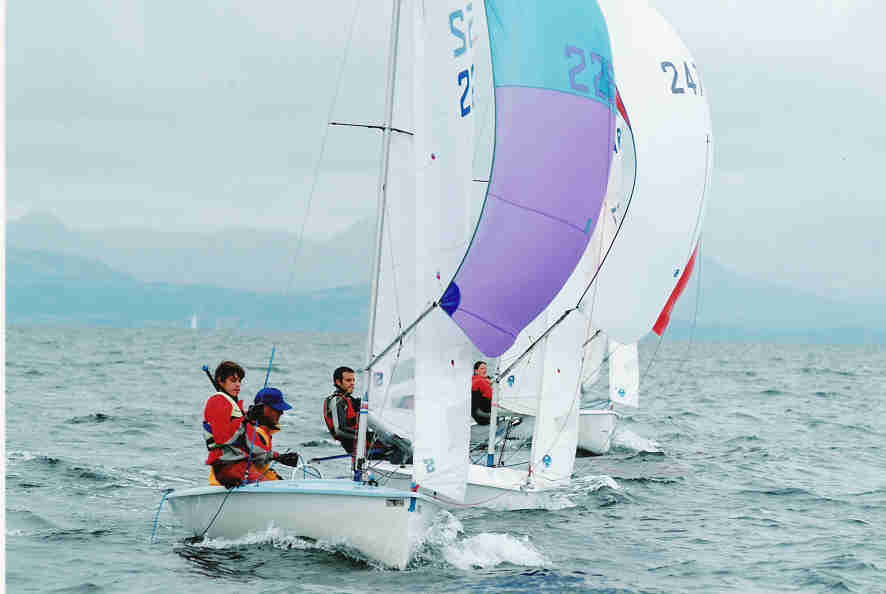



-(1)-202408140552.gif)







Boats for sale
| Laser 28 - Excellent example of this great design Hamble le rice |
 |
| Rossiter Pintail Mortagne sur Gironde, near Bordeaux |
 |
List classes of boat for sale |
Slam dunk? |
Post Reply 
|
Page <12 |
| Author | |
ifoxwell 
Really should get out more 

Joined: 05 Jan 06 Location: Hoo Online Status: Offline Posts: 669 |
 Post Options Post Options
 Quote Quote  Reply Reply
 Topic: Slam dunk? Topic: Slam dunk?Posted: 25 Jan 11 at 10:20am |
I'd consider it bad form at a club meeting. Then i'm just sailing for fun and its no fun being in some ones dirty air. If we are all on the layline or there is a some other reason then so be it.... but just to mess up my day would piss me off. Ian
|
|
|
RS300
|
|
 |
|
gordon 
Really should get out more 
Joined: 07 Sep 04 Online Status: Offline Posts: 1037 |
 Post Options Post Options
 Quote Quote  Reply Reply
 Posted: 26 Jan 11 at 3:51pm Posted: 26 Jan 11 at 3:51pm |
|
1. S is on starboard. P on port. P must keep clear (rule 10) and if S changes course she must give P room to keep clear (16.1)
2 P bears away to pass astern. If S changes course she must give P room to keep clear (16.1) AND, as a result of changing course oblige P to immediately change course to keep clear (16.2). 3 If S luffs to tack she must respect the 16.1 and 16.2 obligations above. 4 If S passes head to wind she must keep clear of P (rule 13). As P acquires right of way by S's actions she is not initially required to give S room to keep clear rrule 15. However, if P changes course she must give S room to keep clear (rule 16.1) 5 When S reaches a close-hauled course she will either be overlapped to windward or clear astern. In either case she must keep clear of P (rules 11 and 12). P must give S room to keep clear if P changes course. Provided she gives room to keep clear P can luff head to wind (rule 17) If P luffs before S passes head to wind she can effectively prevent S from tacking. As soon as S passes head to wind P should hold her course, meaning that S is unable to bear away. With luck and skill P will carry some way leaving S wallowing, and, hopefully, in irons. Gordon |
|
|
Gordon
|
|
 |
|
blueboy 
Really should get out more 
Joined: 27 Aug 10 Online Status: Offline Posts: 512 |
 Post Options Post Options
 Quote Quote  Reply Reply
 Posted: 26 Jan 11 at 5:30pm Posted: 26 Jan 11 at 5:30pm |
Same class? Oh dear, what a shame, they are annoyed. Different class? That's obnoxious. |
|
 |
|
Rupert 
Really should get out more 
Joined: 11 Aug 04 Location: Whitefriars sc Online Status: Offline Posts: 8956 |
 Post Options Post Options
 Quote Quote  Reply Reply
 Posted: 26 Jan 11 at 5:39pm Posted: 26 Jan 11 at 5:39pm |
|
If there is a genuine race going on between the 2 boats, all well and good. If the starboard boat is working her way back up the fleet for some reason and overtaking less experienced sailors, then leaving enough room before tacking for the other boat to tack clear would only be polite.
|
|
|
Firefly 2324, Puffin 229, Minisail 3446 Mirror 70686
|
|
 |
|
GarethT 
Really should get out more 

Joined: 21 Apr 07 Online Status: Offline Posts: 714 |
 Post Options Post Options
 Quote Quote  Reply Reply
 Posted: 26 Jan 11 at 8:15pm Posted: 26 Jan 11 at 8:15pm |
|
The incident in question was in a one design championship race, with both helms in the top 20% of the national fleet.
I totally agree with the comments regarding handicap fleets and less experienced sailors.
ps - ignore my profile picture - it was nothing to do with OKs. In fact, it was nothing to do with me - I am just helping 'starboard' helm come to terms with the grief he is getting! Edited by GarethT - 26 Jan 11 at 8:17pm |
|
 |
|
alstorer 
Really should get out more 

Joined: 02 Aug 07 Location: Cambridge Online Status: Offline Posts: 2899 |
 Post Options Post Options
 Quote Quote  Reply Reply
 Posted: 26 Jan 11 at 8:19pm Posted: 26 Jan 11 at 8:19pm |
|
Crikey, in the situation you describe, especially if late in a regatta and racing for regatta position, it is more than fair game.
|
|
|
-_
Al |
|
 |
|
Garry 
Really should get out more 

Joined: 18 Apr 04 Location: United Kingdom Online Status: Offline Posts: 536 |
 Post Options Post Options
 Quote Quote  Reply Reply
 Posted: 26 Jan 11 at 8:28pm Posted: 26 Jan 11 at 8:28pm |
|
As described perfectly legal. The dunk works best if they don't have to bear away to avoid you, if they have to alter course to go around your stern its hard not to be leebowed. It actually carries some risk, if you get it wrong you will be in the dirty air coming back off of the leeward boat's mainsail. The boat being dunked has a number of strategies, you loose a couple of boat lengths. Unless team racing you can easily loose the plot having tacking duels and move back down the fleet, so unless you need that tactical advantage not worth doing. Garry
|
|
|
Garry
Lark 2252, Contender 298 www.cuckoos.eclipse.co.uk |
|
 |
|
andymck 
Far too distracted from work 
Joined: 15 Dec 06 Location: Stamford Online Status: Offline Posts: 397 |
 Post Options Post Options
 Quote Quote  Reply Reply
 Posted: 30 Jan 11 at 1:29am Posted: 30 Jan 11 at 1:29am |
If the starboard boat does this close to you, and you have had to bear off to duck the starboard boat, it can be very effective, and i suspect almost impossible for the starboard to protest successfully about, even if port has slightly overdone it, as he will be concentrating on his tack, rather than the port boat. You can also make it look as if you did not luff above close hauled if done at speed, and a well timed roll as you head up. Having said that, it rarely pays to duck an opponent from a tactical point of view, a lee bow, even 2 boat lengths to leeward usually gives you more tactical options, unless there is a good reason to go further right. Andy
|
|
|
Andy Mck
|
|
 |
|
gordon 
Really should get out more 
Joined: 07 Sep 04 Online Status: Offline Posts: 1037 |
 Post Options Post Options
 Quote Quote  Reply Reply
 Posted: 30 Jan 11 at 8:52am Posted: 30 Jan 11 at 8:52am |
|
Andy,
A couple of points. 1. The question of whether P sails above close hauled is irrelevant as P has no rule 17 obligation. Any overlap is caused by S passing beyond head to wind and coming on to port tack. However P, once she is right of way boat must, when she changes course, give S room to keep clear? The way to do this is not to luff any higher after S passes head to wind. P may well be above a close-hauled course at that precise moment. 2 it would be impossible for S to protest succesfully, not because she is concentrating on her tack, but because - except as stated above - P does not break a rule! Gordon |
|
|
Gordon
|
|
 |
|
Post Reply 
|
Page <12 |
| Forum Jump | Forum Permissions  You cannot post new topics in this forum You cannot reply to topics in this forum You cannot delete your posts in this forum You cannot edit your posts in this forum You cannot create polls in this forum You cannot vote in polls in this forum |
Bulletin Board Software by Web Wiz Forums® version 9.665y
Copyright ©2001-2010 Web Wiz
Change your personal settings, or read our privacy policy
Copyright ©2001-2010 Web Wiz
Change your personal settings, or read our privacy policy











 Printable Version
Printable Version Delicious
Delicious Digg
Digg Facebook
Facebook Furl
Furl Google
Google MySpace
MySpace Newsvine
Newsvine reddit
reddit StumbleUpon
StumbleUpon Twitter
Twitter Windows Live
Windows Live Yahoo Bookmarks
Yahoo Bookmarks Topic Options
Topic Options